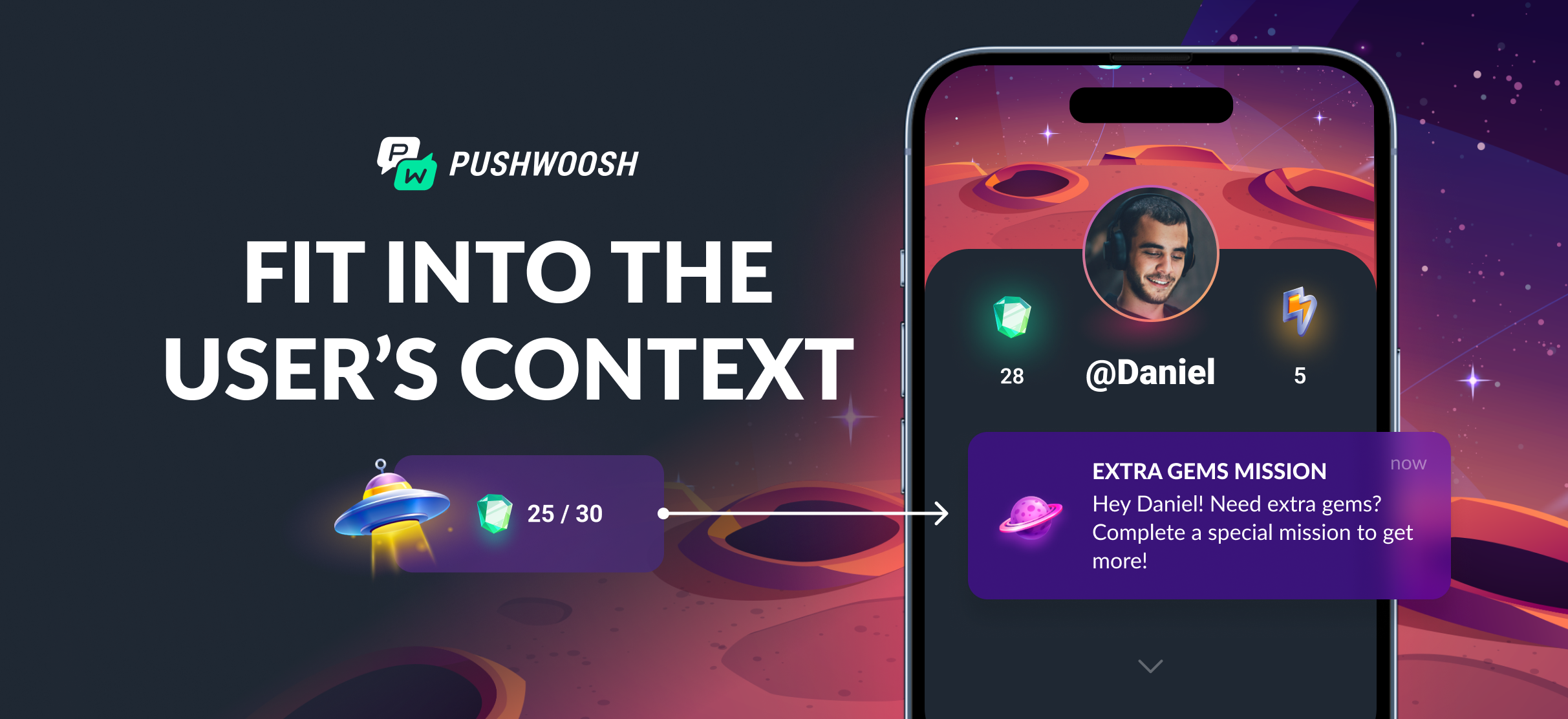We’ve all seen how messaging personalization has evolved over the last decade, from basic tactics such as using the customer’s name to more advanced techniques. Customers now expect a seamless communication experience across multiple channels and devices throughout their customer journey. But what steps do marketers need to take to achieve that level of personalization?
Today, we're not just discussing personalization in theory. We're providing you with practical, actionable tactics that you can start implementing right away to enhance your personalization efforts. We’ll guide you through the steps to create an effective personalization strategy and showcase messaging personalization techniques that can be applied to different customer journey stages using Pushwoosh. While our examples are tailored for mobile game users, they can be easily adapted for digital products in various industries.
Strategy:
4 steps to effective message personalization
Implementation:
How to incorporate personalized omnichannel messaging tactics at various user experience stages
Strategize to maximize message personalization efforts
We've laid out a simple four-stage process that will assist you in creating an omnichannel messaging personalization strategy to effectively interact with your clients.
① Identify communication personalization goals and metrics
🎮 Suppose you are an employee at Space Explorer, a mobile gaming company. You wish to send automated personalized messages to your customers. However, before doing so, it is important to identify what you want to achieve through these messages. Is it to increase the number of active users, enhance user engagement, or generate more revenue? Once you have determined your goal, you can then select the appropriate metrics to track your progress.
Let’s say you aim to generate more revenue, then you might want to track at least the following metrics:
- DAU;
- MAU;
- Time spent in-app;
- Number of sessions and their frequency;
- Number of in-app purchases + what exact items players purchase.
② Audit data sources and centralize customer information
To personalize your user's experience, you need to have a vast amount of data at your disposal.
To begin with, scrutinize your data sources, such as data streaming, product analytics, and CMS platforms, to understand what information you collect about your users.
Once you have identified the relevant bits, you can push them to a customer data platform (CDP) such as Pushwoosh, which can also be used for data collection. Centralizing customer data on a single platform enables you to access and leverage the necessary information at different stages of the customer journey.
🎮 Let's say you want to organize a special event to engage players who downloaded your app through ads. You can make use of our AppsFlyer to Pushwoosh integration and push this audience segment to Pushwoosh. At the same time, Pushwoosh assigns timezone tags to users, allowing targeted push notifications to be sent at the appropriate time for each user.
Send a targeted push notification about the event at the appropriate time for each user (based on their timezone).
③ Segment customers to personalize their experiences
Unlocking the true potential of personalization requires going beyond basic user segmentation based on demographics, behavior, preferences, or needs. We can only unleash the magic of personalization by creating more nuanced user segments based on the information at hand and sending them highly personalized messages.
🎮 Pushwoosh lets you create custom compound segments based on your needs. For instance, Space Explorers could target their most active players by combining users who have been playing regularly and those who made purchases within the last 30 days.
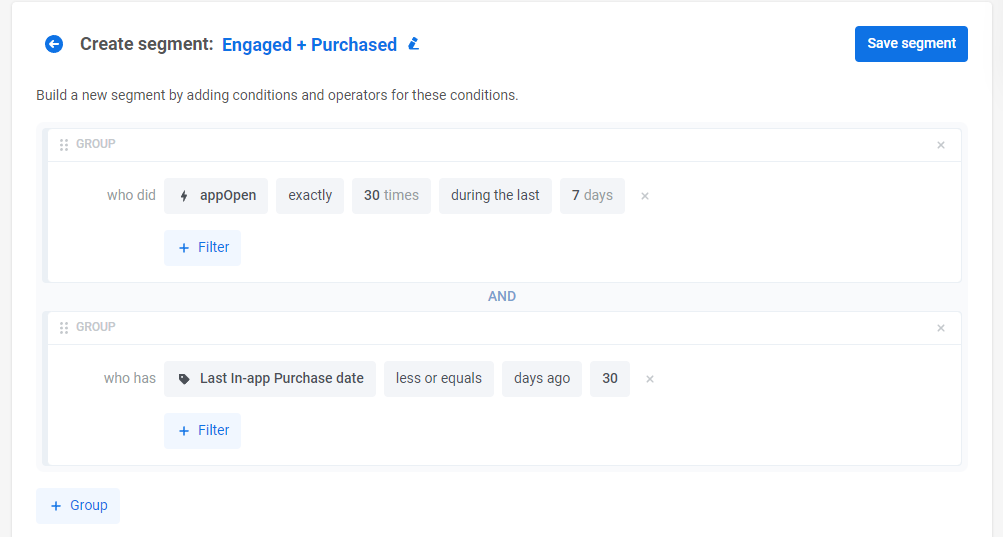
④ Analyze existing messaging personalization tactics
Take a closer look at your recent marketing campaigns and evaluate your messaging personalization efforts.
- Are you ensuring engaging communication at every stage of the customer journey?
- What channels do you use to connect with your customers?
- How do you customize your messages?
- How do your campaigns perform?
- Are there any new ideas you would like to experiment with?
It's important to evaluate your current position if you want to determine the specific actions needed to achieve your personalization goals.
🌟 Beach Bum, a mobile gaming company, implemented Pushwoosh to deliver personalized push notifications featuring emojis and custom sounds, resulting in a threefold increase in CTR. Through automated messaging tailored to the user's preferred language and personalized with their name, the game apps have seen a 2–3x growth in both DAU and MAU. Their promotional push notifications delivered an average CTR of 8%–12%, which is an excellent outcome for a gaming app.
Let's see how Space Explorers could tailor its communication to players at each stage of their journey and increase revenue.
How to incorporate personalized omnichannel messaging tactics at various user experience stages
1. Onboarding 2. Exploration 3. Retention 4. Monetization and post-purchase
① Onboarding
Streamlining the onboarding process is critical for retaining users in any digital product. Optimize their experience with personalized, straightforward instructions to increase adoption and engagement. Use dynamic content to add a personal touch to any onboarding experience. By displaying unique values for each user, you can make your message more engaging and relevant.
🎮Let's take a look at the content that could be dynamically inserted into an in-app message.
In this example, we are addressing players by their names (a well-known trick 🙂) and offering different characters based on the user’s gender.

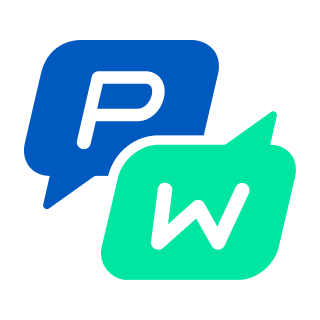
To create a similar in-app message in Pushwoosh, navigate to the Content tab and In-Apps (Rich Media). You have two options: design your in-app announcement from scratch or choose one of the nine templates our team has created. Remember to add variables in the form of tags and events to personalize the message.
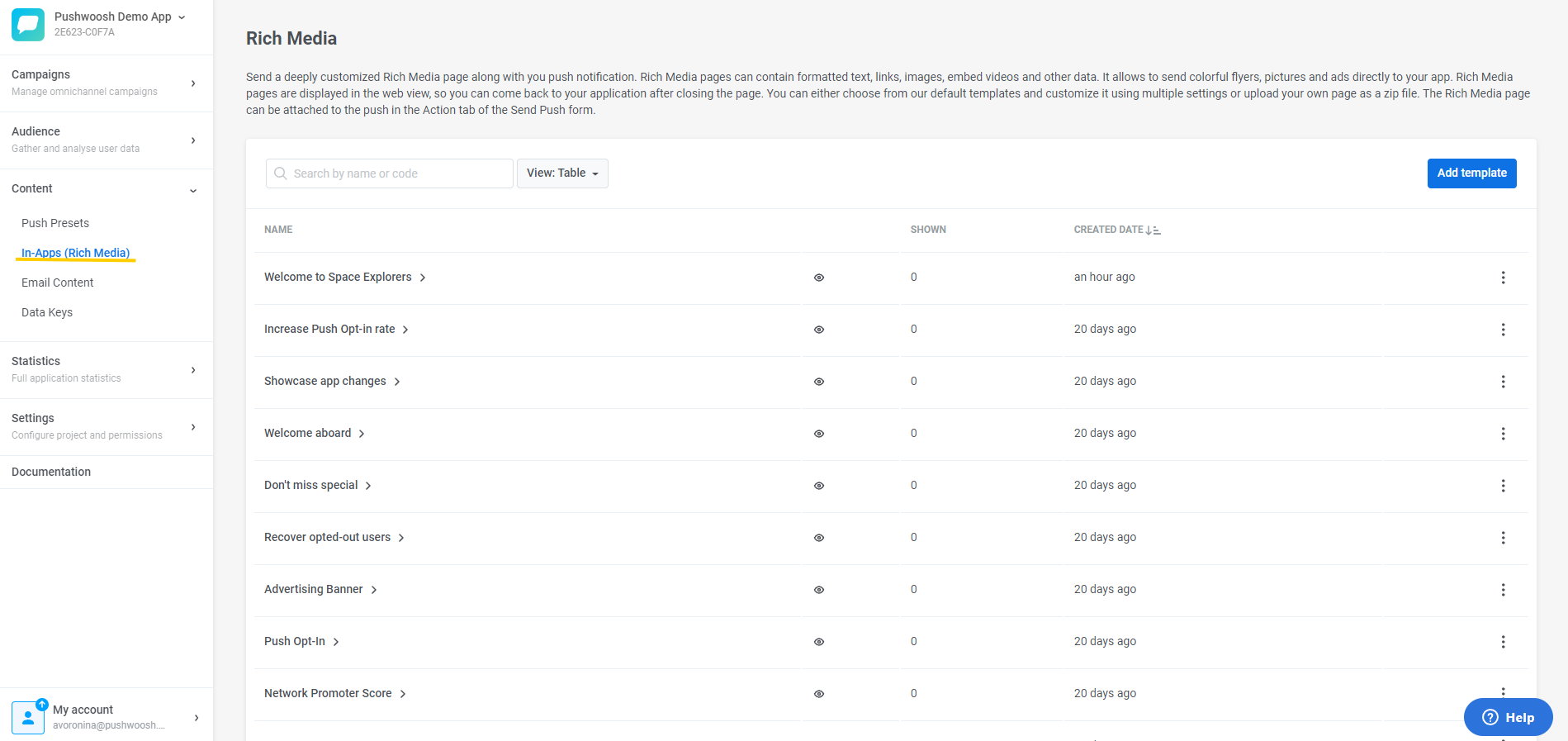
🌟Coupon service Almowafir by Omada has achieved a remarkable 67.4% conversion to target action with personalized onboarding. Furthermore, they have also witnessed a 4% increase in Day 30 retention, a crucial metric for measuring app success.
As a Pushwoosh customer, the app provided personalized content based on users' preferences and behaviors. Learn more about Omada’s personalization tactics from our case study.
② Exploration
While users familiarize themselves with your app's features and assess its value, track and analyze their behavior and preferences. Then put your insights into practice, using Liquid Templates to personalize messages with conditional logic based on specific criteria.
🎮For instance, if a player engages with the app but never purchases, our example Space Explorer app can incentivize their first💲investment by offering them to buy boosters.
One messaging personalization tactic could be sending a push notification with a 20% discount on boosters to non-paying players and a 10% discount to paying customers but for a different set of boosters.
To send a message to these two types of customers, they would need to create only one liquid template. Have a look at what such push notifications’ copy could look like:
Hey {{Name}} 🚀,
{% if Tier == 'free' %}
You're already at level {{level_reached}}, so don’t miss out on our limited-time offer! Get 20% off all {{nozzle_type}}, {{pump_type}}, or {{fuel_type}} purchases. Fuel up now and save big! 💰
{% else %}
You're already at level {{level_reached}}, so don’t miss out on our limited-time offer! Get 10% off all {{tank_type}}, {{frame_type}}, or {{fuel_type}} purchases. Fuel up now and save big! 💰
{% endif %}

Crafting personalized push notifications is easy with Pushwoosh. Navigate to Content, choose Push Presets, and click the Add Preset button. Delegate copywriting to our AI Content Composer. Type in your keywords, and the composer will generate engaging, high-quality copy on any topic, saving you time and energy. For example, this copy was generated by our AI composer.💖
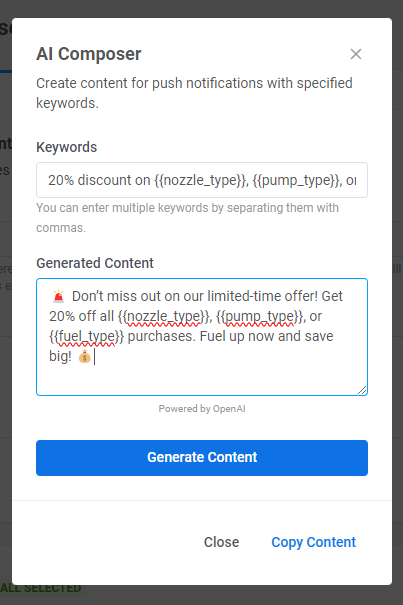
③ Retention
Businesses can nurture customer relationships by providing tailored content, relevant recommendations, exclusive offers, loyalty rewards, and reactivation campaigns via the customer's preferred communication channel. Despite the availability of many communication channels, email remains an effective way to retain and reactivate customers.
💡Pushwoosh is built to deliver personalized messages across different channels. In Customer Journey Builder, you can split the user flow depending on whether the push message was opened or ignored and reach out to them via email, SMS, or WhatsApp.

🎮 If some users don't open the push notification from the example above, you can send them a personalized email after a specific time period. This email will redirect players back to the game, incentivizing them to make an in-app purchase.
If people around the world are playing the game, you could segment players according to their language preferences and email them in their mother tongue to improve engagement. Check out the email copy for Spanish-speaking non-paying players:


Follow these steps to send personalized multilingual emails using Pushwoosh:
1. Go to the Content tab and then to the Email Content tab.
2. Use our drag-and-drop editor to set up the email preset and its copy. Use dynamic content and liquid templates to personalize the email.
3. Remember to add a translated version of your email.
Select the email preset you've created when you configure your omnichannel campaign in our Customer Journey Builder. Watch a short video to see how we set up an email.
④ Monetization and post-purchase
During the monetization stage of the customer journey, personalizing messaging can be an effective way to boost conversions, maximize revenue, and increase the overall lifetime value of a customer. Targeted offers, reminders of abandoned carts, cross-selling and upselling products, renewal reminders for subscriptions, and exclusive event access offers are all examples of communication touchpoints you can use to send personalized marketing messages.
🎮 Besides selling boosters, Space Explorers could earn more revenue by offering players to unlock new characters. The team could personalize the experience by sending in-app messages with different spaceship images based on the player's engagement level.

To provide a smooth user experience, Space Explorers’ team would probably choose to notify its users about purchases they’ve made with an in-app message, followed by an email receipt from Google Play or App Store.

On the other hand, finance, healthcare, hospitality, or retail companies could choose other relevant channels for purchase and post-purchase communications, such as SMS and WhatsApp. Pushwoosh allows the personalization of transactional and post-purchase messages too. Here's an example of how a hospitality company could personalize its post-purchase messages.

When sending SMS messages in other languages, it's important to use a compatible character encoding. Unicode encoding is the most reliable option for sending multilingual SMS messages, but carriers or devices may impose limitations.
💡Check your campaign’s performance in your reporting dashboard to ensure you’re on track with your personalization goals.
🌟 Pushwoosh customer HungryNaki is a testament to the power of personalization tactics. The food delivery app personalized each message based on user behavior, such as views of a specific restaurant page or orders of a certain cuisine. This led to a surge in order volume and average order value (AOV), all contributing to enhanced customer lifetime value.
Next steps: take action to craft personalized omnichannel messages
We hope we’ve inspired you to experiment with some messaging personalization tactics we’ve covered. Don't hesitate to be creative and mix and match communication channels, tailor your messaging structure to suit your customers' needs, and employ various personalization techniques to determine what resonates best with your customers.

